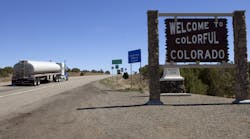Registration opened this week for fleets looking to participate in Federal Motor Carrier Safety Administration’s Safe Driver Apprenticeship Pilot Program, which will study how younger drivers operate in interstate commerce.
Up to 3,000 commercial drivers between 18 and 20 years old will be accepted into the program, which is backed by the departments of Transportation and Labor and is part of the 2021 Infrastructure Investment and Jobs Act. Professional drivers younger than 21 are not permitted to operate beyond their home state. This pilot program would grant those drivers exemptions from this federal law.
FMCSA is seeking up to 1,000 motor carriers to participate in the program, according to Nikki McDavid, chief of the Commercial Driver’s License Division in the FMCSA’s Office of Safety Programs. The agency is also looking for fleets of all sizes and operations across the country to gather as much diverse data, she added.
“Safety is our focus and will remain our focus for the entire duration of the pilot program,” McDavid said during an FMCSA information session she led on July 25.
See also: Safety groups question merits of federal driver apprenticeship program
Carrier requirements for Safe Driver Apprenticeship Pilot Program
As part of the safety focus, only carriers in the highest standing with FMCSA can participate in the pilot program. Participating drivers younger than 21 must have a valid CDL and clean driving record (no past license suspension, traffic law or DUI convictions, driving-related felonies, or refusals to take a drug or alcohol test, etc.).
The pilot requires those young apprentices to be in trucks with automated manual transmissions, active braking collision mitigation systems, in-cab cameras, and a governed speed of 65 mph. They also must complete training periods under the supervision of an experienced commercial driver in the passenger seat.
To qualify for participation in the Safe Driver Apprenticeship Pilot Program, fleets must meet the following standards:
- Must have proper operating authority, if required, and registration;
- Must have at least the minimum levels of financial responsibility required by the FMCSRs;
- Must not be a high or moderate risk motor carrier as defined in the Agency’s Federal Register notice titled, ‘‘Notification of Changes to the Definition of a High-Risk Motor Carrier and Associated Investigation’’;
- Must not have a conditional or unsatisfactory safety rating;
- Must not have any open enforcement actions ( Imminent Hazard, Operations Out-of-Service Orders, Patterns of Safety Violations, etc.) in the previous six years;
- Must not have a crash rate above the national average;
- Must not have a driver OOS rate above the national average; and
- Must not have a vehicle OOS rate above the national average.
The current OOS rate for participating carriers must not exceed 5.3% and a vehicle OOS rate not be more than 19.4%, based on the 2021 national averages. Carriers must also have an average crash rate of 0.96% or less.
FMCSA intends to review carrier applications and notify fleets of acceptance decisions within 30 days of submissions. Those fleets accepted into the pilot program must attend a webinar to discuss participation requirements before enrolling drivers. FMCSA intends to hold these webinars monthly, depending on demand during the three-year pilot program.
New slots would open up throughout the program term as drivers age out or leave the program.
“Once we hit that 3,000-cap, we will not be enrolling anymore until drivers age out, choose to leave the program, or leave the profession,” explained Nicole Michel, program manager with FMCSA’s Office of Research and Registration. “So it will be very dependent upon enrollment levels and how we were getting drivers enrolled. But we're planning on working with carriers that apply and are accepted. We’re committed to making sure that you have available room to hire apprentices because you’re volunteering and being accepted into this program.”
See also: What carriers need to know about the FMCSA’s driver apprenticeship program
What’s next after a carrier is approved?
Motor carriers can accept apprentices 30 days after receiving FMCSA approval notice. Before accepting apprentices, fleets must identify experienced drivers that supervise apprentices. Carriers must also register with the Department of Labor to get a Registered Apprenticeship number. That registration can be done while FMCSA is reviewing the Safe Driver application.
Drivers younger than 21 would apply for the Safe Driver Apprenticeship Program through approved motor carriers. Those carriers will be listed on the FMCSA’s pilot program webpage.
The current proposal requires data on safety and other incidents involving the apprentice. That gathered information includes crash data, inspection data, citation data, safety event data (those recorded by installed safety and advanced driver assistance systems), video recordings, and exposure data (record of duty status logs, on-duty time, driving time, etc.).
Fleets will also be asked to report any additional or remedial training to participating drivers. All this data is to be submitted monthly by participating motor carriers, which would be part of a report on the pilot program.
Fleets interested in participating in the pilot program can apply through the FMCSA Safe Driver Apprenticeship Pilot Program webpage.





